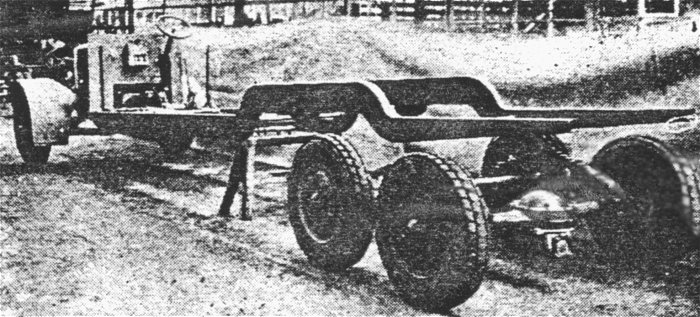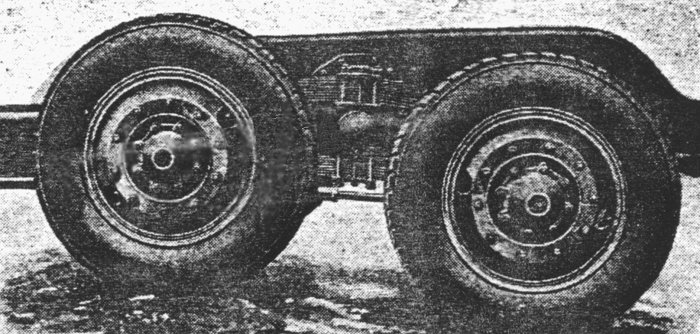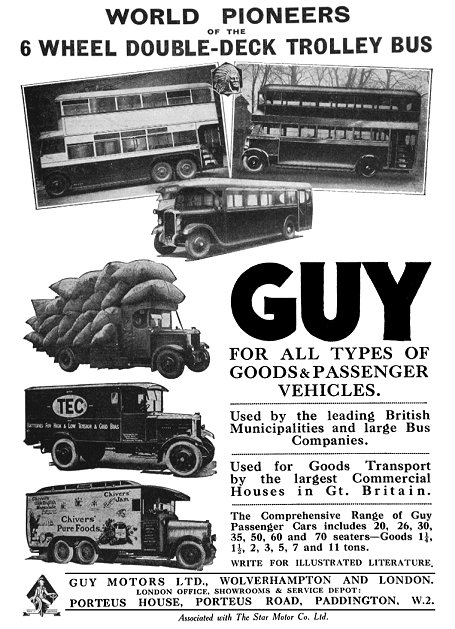|
The Guy Rigid
Frame, Six-Wheeled Chassis
An article from 'The World's
Carriers', 15th September 1926. Courtesy of Brendan Kinsella. |
|
The New Guy Six-Wheeler
Quite recently by the courtesy of Guy
Motors, Limited, Fallings Park, Wolverhampton, we were
privileged to inspect two examples of their rigid-frame,
six-wheeled chassis; one fitted with a 56-seater top deck bus
body, by Christopher Dodson, Limited, built to the order of the
Wolverhampton Corporation, and the other fitted with a 53-seater
double-deck body by Messrs. Short Bros. (Rochester and Bedford),
Limited, being one of six built to the order of the Morecambe
Tramways.
The 56-seater model was fitted with a 45
hp. Knight steel sleeve valve engine, whilst the 53-seater was
fitted with a standard Guy 38 hp. four-cylinder engine. The
56-seater has the distinction of being the first enclosed top
double-decker on six wheels, whilst both models are said to be
the first rigid six-wheeled buses to be mounted on pneumatic
tyres. |
|

Plan view showing rear axle. |
Both models may, if required, have forward controls as an
alternative to the orthodox design. The design and construction
of both models were adopted after eighteen months severe tests
and experiments to ensure the production of an efficient vehicle
which would not only transport passengers over the roughest
roads with increased comfort and safety, but which would also
cause minimum road wear, and at the same time be economical in
both running and maintenance costs.
The forward part of the Morecambe model follows the standard
Guy practice, which has proved so satisfactory for their
four-wheeled type, i.e., it has the Guy four-cylinder engine
with the Guy patent valve design, detachable cylinder heads, and
the Guy three-point suspended sub-frame, which carries the
engine and gear box, insulating thereby the engine clutch and
transmission from all stress due to frame distortion, i.e., when
the main frame is badly distorted as a result of an accident, or
when one rear wheel is raised a considerable height, the
sub-frame remains in true alignment, so that the torsional
strain is not transmitted to the crank case and gear box arms,
and there is no tendency for the clutch and change speed
mechanism to bind.
Another advantage of this construction is that, in the event
of an accident and the main frame getting damaged, by
unfastening three points of suspension, the sub-frame carrying
the engine, clutch, gear box, universal joints complete with
propeller shafts can be supported by jacks and the main frame
lifted over six units. |
|

53 seater, six-wheel Guy omnibus, one of
six for the Morecambe Corporation Tramways. |
|
The main frame, the side members of which
are of channel section, tapers to the front and rear, is
specially designed to give low loading. The frame is raised over
the two rear axles, this raised portion coinciding with the
longitudinal seats along the rear of the inside of the body.
Although this model has such a low load line there is a ground
clearance of nine inches beneath the axle casings, which renders
the model eminently suitable for use over rough colonial roads
and bush tracks. Further more, the design lends itself admirably
to the fitting of a pantechnicon body, with the usual rear well,
a point which will be appreciated by furniture removers and
others, where the low load line often times makes the difference
of one or two men in the loading and unloading of pianos, heavy
pieces of furniture and other goods.
In the mounting of the two rear axles the
semi-bogey method has been adopted. A strong tubular cross
member, connected with brackets, bolted to the side-frame
members, central between the two rear axles, takes the weight of
the load. At both ends of the cross tube, independent spring
swivel brackets are mounted on plain metal bearings, the latter
being lubricated by an oil gun adapter in the cap. Two pairs of
half-elliptical springs, 3 ft 9 ins. long, are at their centre
anchored above and below each spring swivel, the spring
extremities are bushed and connected with the axle brackets. |
|

Illustrating the ease with which the bogey
can be slid from under the chassis. |
| Two sets of brakes are provided, both brakes operating on
drums, on each of the four rear-wheels. The brake drums are
fitted with renewable liners, with flanges which register with
similar flanges on the brake drums proper, and provision is made
to lead away any surplus oil from the drums; covers are also
provided to keep out, dirt and water. The brakes have been
carefully designed to give equal braking under all conditions of
loading and axle movement. |
|

Illustrating the flexibility of the
semi-bogey rear axle over rough ground. |
|

The Guy six-wheeler, showing tyres that
have completed 18,000 miles. |
The two Guy undertype
worm-driven axles are both complete with differential, and are
inter-connected with a universally jointed-driven shaft. The
axles are fully floating, so that the weight of the vehicle and
load is not carried by the axle shafts. By withdrawing the
shafts which are attached to the hubs, and disconnecting the
rear universal joints, the whole of the gears and internal parts
of the axles can be removed without jacking-up the vehicle or
without using a pit. The wheels cannot become detached if an
axle shaft breaks. |
|
By unfastening the eight cross tube,
bracket bolts and after disconnecting one universal joint, brake
rods, and jacking up the frame, the whole rear axle bogey can be
wheeled away from the chassis, if this part of the vehicle
requires overhauling. This semi-bogey method of mounting the
rear axle has many advantages, amongst which are the following:-
(l) Half rear axle weight, consequently tractive resistance is materially reduced.
(2) By having two axles driving, there can
be no wheel spin except when the wheels are off the road at the
same time, the chance of which' is very remote, furthermore, the
elimination of wheel spin reduces the wear and tear of tyres.
(3) Where there are two driving axles, the
tendency to skid is very materially reduced. (4) The advantages
of four-wheel brakes without complicated front wheel attachment.
(5) Having reduced the load on the back
axle by half and, further, owing to the particular type of
springing employed, the vertical movement of the vehicle over an
obstacle is half, and the vehicle and passengers are only
subjected to a quarter the shock.
(6) Owing to the elimination of wheel spin
and reduced tractive resistance, much greater efficiency of the
vehicle is attained for the same load compared with a
four-wheeled vehicle; one obtains reduced petrol consumption. We
understand that petrol consumption with the model in question
averages from 9 to 9½ miles per gallon.
(7) With the method of springing employed,
if pneumatic tyres are fitted and one wheel should deflate, the
bus only leans over one-half the amount which the wheel drops by
deflation, in fact, it is a negligible amount. During our visit
we took advantage of the opportunity to take a short run in the
53-seater model, through the run along the Cannock Road. Both
inside and on the upper deck, the riding was remarkably
comfortable; furthermore, the shock from the many road
irregularities encountered was practically imperceptible. The
combined comfort and safety of the Guy rigid six-wheeler should
prove highly popular with the general public.
The main dimensions are: four-cylinder
model, overall length, 24 ft. 7 ins.; wheelbase, 15 ft.; track
front, 6 ft. 3 ins.; rear, 6 ft. 2 ins. Six-cylinder model,
overall length, 25 ft. 2 ins.; wheelbase, 15 ft. 9½ ins.; track
front, 6 ft. 3 ins.; rear, 6 ft. 2 ins.
With the exception of the engine and clutch
of the six-cylinder model, both models are almost identical in
other details.

An advert from 1930.
|
 |
Return to the
previous page |
|